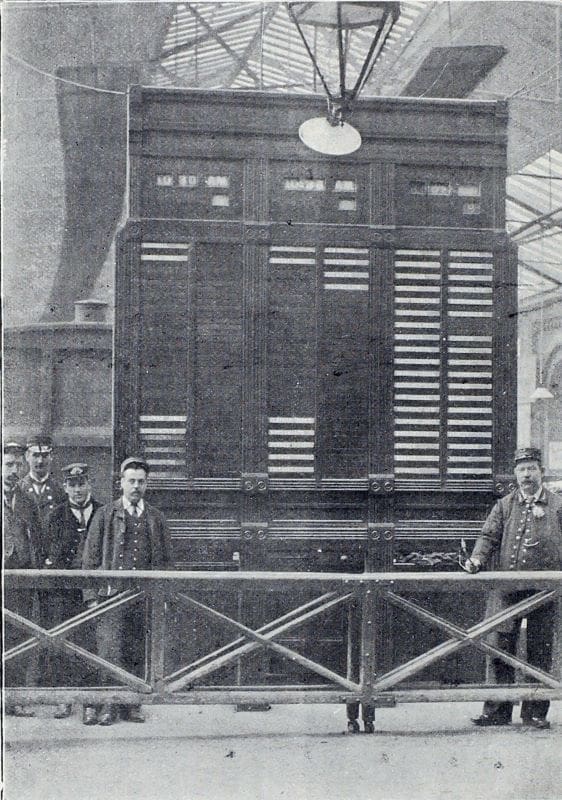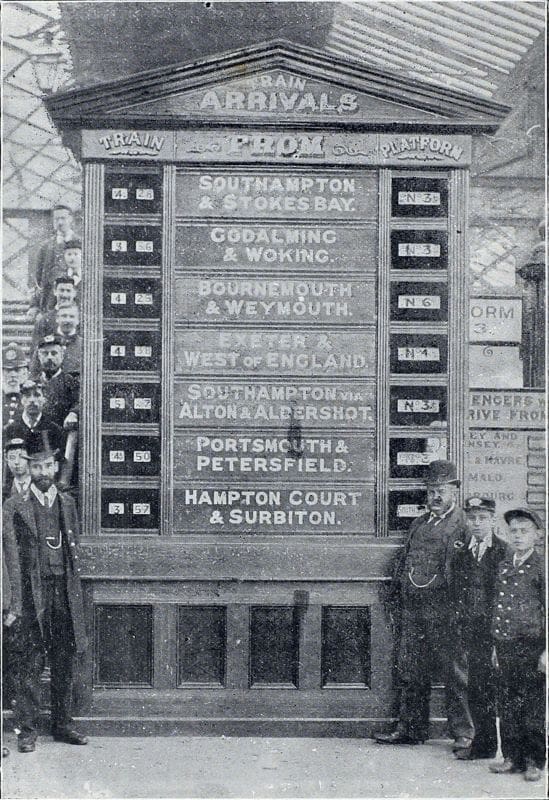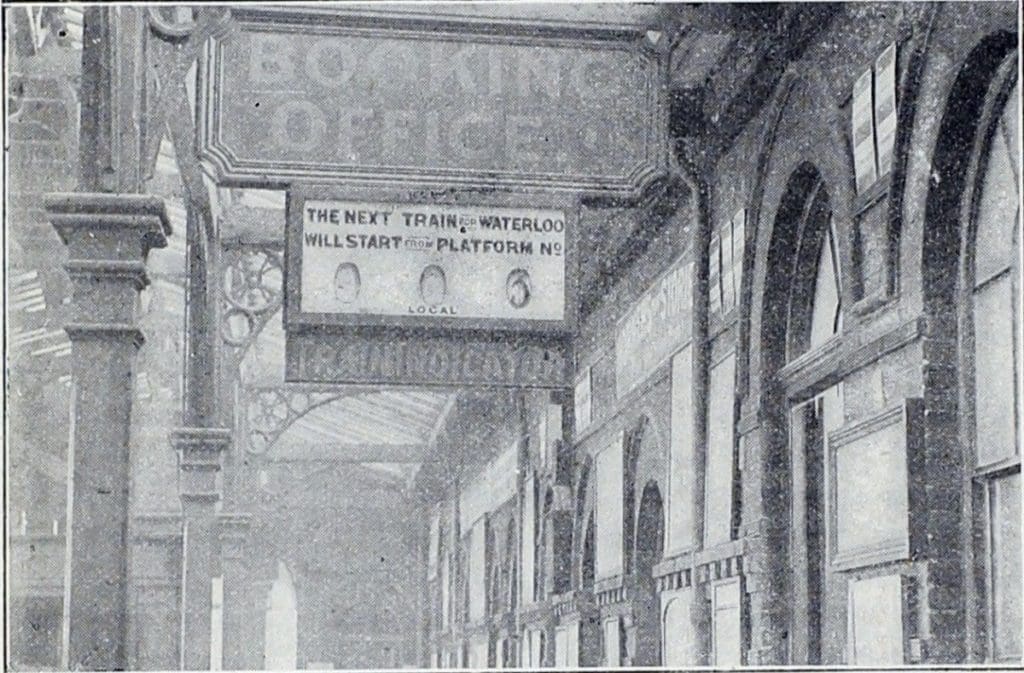Read this fascinating article from the January 1898 issue of The Railway Magazine, written by N. WILSON, then Superintendent of Line’s Department, L. & S.W.R.

T0 those readers of the RAILWAY MAGAZINE who are not acquainted with the Waterloo terminus, I may say that the average number of loaded trains dealt with between the hours of 5.20 a.m. and 12.20 midnight is 630 – giving a train, either in or out, every two minutes for nineteen hours. Waterloo Station extends from York Road on the North to Aubin Street, Lower Marsh, on the south, and from Waterloo Road on the east to Westminster Bridge Road on the west; a total area of about twenty-two acres. There are twelve platforms and eighteen roads, all of which are used for both arrival and departure. The usual practice at terminal stations is to have certain platforms for departure and certain platforms for arrival trains. At Waterloo, owing to the enormous traffic and the insufficient size of the station, this cannot be done. Hence it follows that a train which starts today from No. 6 may start from No. 7 tomorrow, and No. 8 next day, and so on. And the same thing happens with regard to arrivals.
It will be easily understood, therefore, that the description of the confusion so graphically portrayed by J.K. Jerome in “Three Men in a Boat” was (at one time) not too far-fetched. All this has now been changed by the introduction of a most elaborate and complete system of train indicators.
Enjoy more Railway reading in the monthly magazine.
Click here to subscribe & save.
First and foremost among train indicators we must place time-tables, but time-tables are a little too complicated for the average British passenger in a hurry. Consequently we find a board in the booking-offices, and a gigantic slate on the cab approaches (see photo No. 1), where constables wrote in chalk the departure times of the principal trains. The history of the train indicators is the history of the human race, according to Darwin, viz., evolution and survival of the fittest. The policeman’s slate, though useful, did not give sufficient information. The next step was the provision of a bigger slate, and the insertion of the name of the terminal station at the other end of the journey, thus, “7.45 a.m., Hampton Court train, starts from No. 2 platform.” Then comes a series of boards, with the names of several stations painted on them, and so constructed that they will slide in, on grooves, in centre of slate, so that one may be changed for another as trains depart. For example, take out 7.45, as previously referred to, and insert “8.5 a.m., Southampton, Portsmouth and Weymouth train, starts from No. 1 platform.”

Twelve or thirteen years ago a most excellent machine was set up between Nos. 6 and 7 platforms, on the Windsor line station (now called the North Station), at Waterloo (see photo No. 2). It is, I believe, an American invention, and was introduced to the S.W. Railway by a member of the board of directors. This station indicator is manipulated by means of a key and card arrangement, and its internal economy reminds one very much of a piano. The cards are inserted at the bottom of the machine, and they are perforated where the rods are to go through, so as not to show the stations at which the train does not stop. A solid card is provided for cleaning the tablets, on which are printed the names of all stations on the loop, Richmond New, East Putney and Wimbledon, Kingston, Shepperton, Windsor and Reading lines. The tablets are very similar in appearance to the laths of a venetian blind, and are actuated by rods in much the same manner as the Venetians are opened for the admission of light without pulling up the blinds. There is a speaking instrument from this indicator to Waterloo shunting yard, and an attendant always on duty to manipulate the indicator and answer questions. Particulars of three trains can be shown at one time, and altogether this is the most complete and the best indicator of which I have any knowledge. The regular travellers from the North Station never think of troubling the station staff re the departure of trains, but go and consult the indicator.
Many striking and remarkable scenes have been witnessed in front of this machine. One very foggy winter, when the train service was much delayed, I heard hearty and prolonged cheers (that would have done credit both in volume and sincerity to the most important political meeting) from a dense crowd of two or three hundred people when a belated train was shown. This machine has proved a real boon, not only to passengers, but likewise to the company’s servants, who before its introduction were worried almost to distraction by unfortunate travellers enquiring of everyone they saw in uniform where the next train to Clapham Junction started from, and, when told, going forthwith and worrying someone else by asking if there wasn’t a train “before the next.” Nowadays it is much the safest plan, even for the most experienced officials, to refer all applicants to the indicator, because the platform for any particular train is liable to be changed any day, and almost any minute.
The North Station indicator at Waterloo is, I think, as near perfection as it is possible to get in these degenerate days, but the Main Line departure trains are not quite so easily disposed of. The trains departing from the North Station serve some fifty odd stations in all, and the longest journey is under fifty miles. The trains departing from the Main Line platforms serve the remaining 200 stations, and the longest journey is about 250 miles. It is evident, therefore, that an indicator capable of showing every station on the Main Line is a large order, and, if not an impossibility, at any rate impracticable. Something, however, had to be done in that direction, and after many attempts a large machine has been erected on the square at the junction of Nos. 1 and 2 platforms (see photo herewith) which answers well. This indicator was constructed in the Company’s own workshops, and the rumour goes that before it was commenced an outside firm was requested to send in an estimate of the cost of an indicator somewhat similar to the one at the North Station. This estimate was so excessive that it practically frightened a wealthy corporation like the S.W. Railway Company, which does not stick at trifles where the convenience of passengers is concerned. I give this rumour for what it is worth, but whatever negotiations there may have been the result was that our own engineers’ building department was entrusted with the work——the practical carrying out of which, in the capable hands of their foreman, Mr. Crocker, has given the public the present useful machine. It is the second indicator erected here, and has been constructed by Mr. Crocker from a process of altering and improving on his models till he got what he wanted. It is a handsome structure, serving all practical purposes. It is also the acme of simplicity so far as its working parts are concerned. The figures and the names of stations are painted on large wooden rollers, which are a distinct improvement on the original tapes, as these are liable to break and get tangled and out of order, thus necessitating continual repairs. Such an arrangement did not suit Mr. Crocker, as besides constructing the indicator he was also responsible for keeping it in repair. With his system of letters and figures, painted on wooden rollers, he anticipates that the total cost of keeping the machine in working order will not exceed £1 per annum.


The advent of Mr. G. T. White, as Superintendent of the Line, gave a much-needed impetus to the construction of train and station indicators on the S.W. Railway. One of his first reforms was to have each coach of every train labelled with a destination board on both sides. Another most excellent arrangement was the provision of electrical indicators near the booking offices at Vauxhall and Clapham Junction showing from which platform the next train left for Waterloo. As there are three up platforms at both of these stations, the train indicators in the tunnels supplied really a “long-felt want.” I would like to add in this connection (if the Editor of the RAILWAY MAGAZINE will allow me) that what we want most at Clapham Junction now is another tunnel, with lifts to each platform for milk and luggage. Another form of indicator (see photo above) has recently been attached to the girders over the South Station platform at Waterloo, principally for the information and guidance of the platform staff. These indicators, of which there are four, consist of a string of capital letters overhanging each road, and are manipulated from the “A” signal-box, from whence all the traffic is controlled. When a train arrives that is to be loaded forthwith, say for Leatherhead or Kingston, the letter L or K, as the case may be, is shown on the indicator. The nominal position of these letters is side by side and parallel with the running lines. When in use, to indicate how a train is to be disposed of, they are turned broadside on, like the old disc signals.
So far we have dealt only with departure trains, but it has long been thought that some attempt ought to be made to construct an indicator showing the platforms where trains would arrive. Hitherto the great drawback to meeting a friend coming to Waterloo by train has been the uncertainty as to which platform the train would arrive at. The highest official was as ignorant as the humblest porter, it being quite impossible for either of them to say where a train was sure to arrive. Only “A” box could decide, and even “A” box wasn’t certain many minutes beforehand where it could place a particular train. People could not goto the signal-box‘ for information, and the only thing they could do (and in this they were indefatigable) was to worry the uniform staff, and on a Monday or Saturday, during the excursion season, the Company’s servants of every grade had to pass through a most trying ordeal in endeavouring to satisfy people who refused to be satisfied. Every man was threatened with the most disagreeable penalties because he could not impart information which he did not possess. It was most unsatisfactory for everyone, but most of all to the railway servants. It is evident that any man would be only too glad to give a satisfactory answer to a plain question and have done with it, but at a station like Waterloo this was impossible, for we have here to get a bushel of traffic into a peck of platforms, and the difficulty formerly experienced of giving reliable information, re departure platforms, was intensified with respect to arrivals. For this reason: people who come to meet friends arriving by train are often entire strangers who probably never use the station, while the great majority of passengers who depart therefrom are as familiar with Waterloo as with their own houses. At last, however, we have got an arrival train indicator. At the time of writing, though in use, it is not quite completed, but before this article is published it will be in full swing, and should prove an immense relief to everybody.
This indicator has been constructed by the Company’s workmen, under the foremanship of Mr. Crocker, a portion of the old machine first erected on the Main Line departure being utilised for the purpose. Rollers have been substituted for the endless tapes which were used for the figures on the original machine. It is placed at the end of No. 7 road, between Nos. 3 and 4 platforms (see photo on page 56), and in connection with it there have been fixed three of “Tyers’s” electrical train describers. These are fitted with dial plates, on which are inscribed the different trains and platforms. When a train leaves Vauxhall it is described by “A” box to the indicator-box. A dial peg is inserted opposite the particular train on the dial plate; and also opposite the number of the platform to which the train will run on another dial plate. Similar operations are carried out at the indicator-box, and then the attendant sets the indicator for the information of passengers, visitors, and staff. “A” box sets and releases the describers in the indicator box, and the indicator-box sets and releases the instruments in “A” box.

During the fitting up of this arrival indicator I have been a good deal in Mr. Crocker’s company, and in the course of our numerous conversations I asked him where he got the original idea from, and if he had any plans put before him to work upon. For a reply he went to a drawer in his workshop and took out a scrap of paper, on which was Written, “11.45 a.m., Salisbury, Yeovil and Exeter line train. Starts from No. 1 platform.” “This, “said Mr. Crocker, “is all I had. I cannot say now who it was that gave it to me, neither do I know the writing. It has been in my possession for some years, and it is the pip or kernel from which these Main Line indicators have sprung. I have lain awake in bed hours and hours studying the thing out, and I have constructed models and sections in great numbers before I could get an apparatus to satisfy myself. I knew well enough if I wasn’t satisfied it would be useless for me to introduce the machines to my superiors. When at length I got the idea worked out I obtained permission to construct one complete section of full size, and here it is,” and he pointed to an indicator fixed on the wall of the workshop. I thanked him for his kind and complete information, and I was able to impart a little information in return, for I recognised the writing on the scrap of paper before mentioned; and RAILWAY MAGAZINE readers will, no doubt, be as interested as was Mr. Crocker to know that the calligraphy was in the (to me) familiar hand of Mr. W. H. Hilditch, Station Superintendent, Waterloo.
I have omitted to say, when “speaking of the survival of the fittest” with regard to train indicators, that most of the policemen’s slates, etc., are still in daily use, and when the arrival indicator is completed, Waterloo will have such an array of indicators as no other station can equal; and the visitors to our terminus, whether intending to travel or only to meet a friend, will not need to worry the staff about the trains, if they will only use their eyes. I have long been of opinion that if the average passenger would use his eyes a bit more and his tongue a bit less it would greatly smooth the difficulties which are inseparable from the working of an enormous traffic. It is, of course, most annoying when a passenger cannot get a satisfactory answer to a straightforward question, but in providing an elaborate system of indicators, at a great expense, I am sure the S.W. Railway Company has done all it possibly can to minimise the inconveniences of Waterloo Station, and I trust passengers will thoroughly appreciate their efforts in that direction.
At the beginning of this article I mentioned the description of Waterloo in the book, “Three Men in a Boat.” Singular to say, I have just come across a criticism of Waterloo in the journal To-day, which is rather a strange coincidence, and it will most likely seem so to all who know the connection between the editor of that paper and the author of the book. It appears from what the “Major” says in the journal in question that Waterloo is not yet perfect. I would remind this gentleman that criticism is easy. I would also remind him that someone has said, “Comparisons are odious.” Were it not so I might quote from contemporary literature more than one paragraph in which the working of the traffic at Waterloo has been held up as a model to the very station which he praises at our expense. But whatever faults may be found and holes picked with regard to other points, I think everyone who knows Waterloo will admit that our officials have set an example to all other railways in the provision of train indicators.





